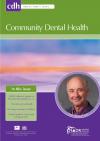Community Dental Health

- Cover Date:
- June 2016
- Print ISSN:
- 0265 539X
- Vol:
- 33
- Issue:
- 2
Examiner reliability in fluorosis scoring: a comparison of photographic and clinical methods
Objective: To assess examiner reliability when scoring dental fluorosis in Malaysian children using clinical (Dean’s Index) and photographic methods. Method: The upper central incisors of 111 children were examined both clinically and photographically for fluorosis status using Dean’s index. Twenty children were re-examined after a two-week interval for intra-examiner reliability by a single examiner. In addition, two independent examiners and the clinical examiner scored 111 photographic images of the same children in a standardized manner. Fluorosis scores were compared individually between examiners for both clinical and photographic scoring. Examiner reliability was assessed using both simple and weighted kappa statistics at tooth level. Sensitivity, speciï¬city, positive-negative predictive values and
a Receiver Operating Characteristic (ROC) curve were also calculated to determine the accuracy of the test. Results: Across the three examiners, the prevalence of fluorosis (Dean’s score ≥2) using photographs was lower (ranged from 23% to 26%) than the prevalence recorded by clinical examination (30%). The kappa score for intra-examiner reliability for the duplicate clinical examination was excellent(0.89). Inter-examiner reliability between the photographic method and the clinical examination (gold standard) for each examiner was substantial with weighted kappa values ranging from 0.74 to 0.77. The photographic method indicated higher speciï¬city (99%) than sensitivity (79%) and the area under the ROC curve was also high (0.89) which suggests good accuracy of the diagnostic test.
Key words: Dean’s index, dental fluorosis, Malaysia, reliability, photographic, clinical
doi:10.1922/CDH_3873Nor06
- Article Price
- £15.00
- Institution Article Price
- £
- Page Start
- 145
- Page End
- 150
- Authors
- N.A. Mohd Nor, I.G. Chestnutt, B.L. Chadwick
Articles from this issue
- Title
- Pg. Start
- Pg. End
- Child oral health in migrant families: A cross-sectional study of caries in 1-4 year old children from migrant backgrounds residing in Melbourne, Australia
- 100
- 106
- Feasibility, utility and impact of a national dental epidemiological survey of three-year-old children in England 2013
- 116
- 120
- A bi-level intervention to improve oral hygiene of older and disabled adults in low-income housing: results of a pilot study
- 127
- 132
- Caries and costs: an evaluation of a school-based fluoride varnish programme for adolescents in a Swedish region
- 138
- 144
- Examiner reliability in fluorosis scoring: a comparison of photographic and clinical methods
- 145
- 150
- Do ‘poor areas’ get the services they deserve? The role of dental services in structural inequalities in oral health
- 164
- 167
